Analyzing the Implications of Virtual Technology in Education
VerifiedAdded on 2023/06/10
|5
|1166
|68
Essay
AI Summary
This essay discusses the implications of virtual technology for the education sector, highlighting its potential to make learning more engaging and effective. It argues that virtual reality can capture students' attention, improve the quality of education, and address the challenges of monotonous teaching methods. While acknowledging concerns about infrastructural limitations and potential distractions, the essay concludes that the benefits of integrating virtual technology into education outweigh the drawbacks, ultimately enhancing the learning experience for students. Desklib offers a wide range of study tools and solved assignments to support students in their academic endeavors.
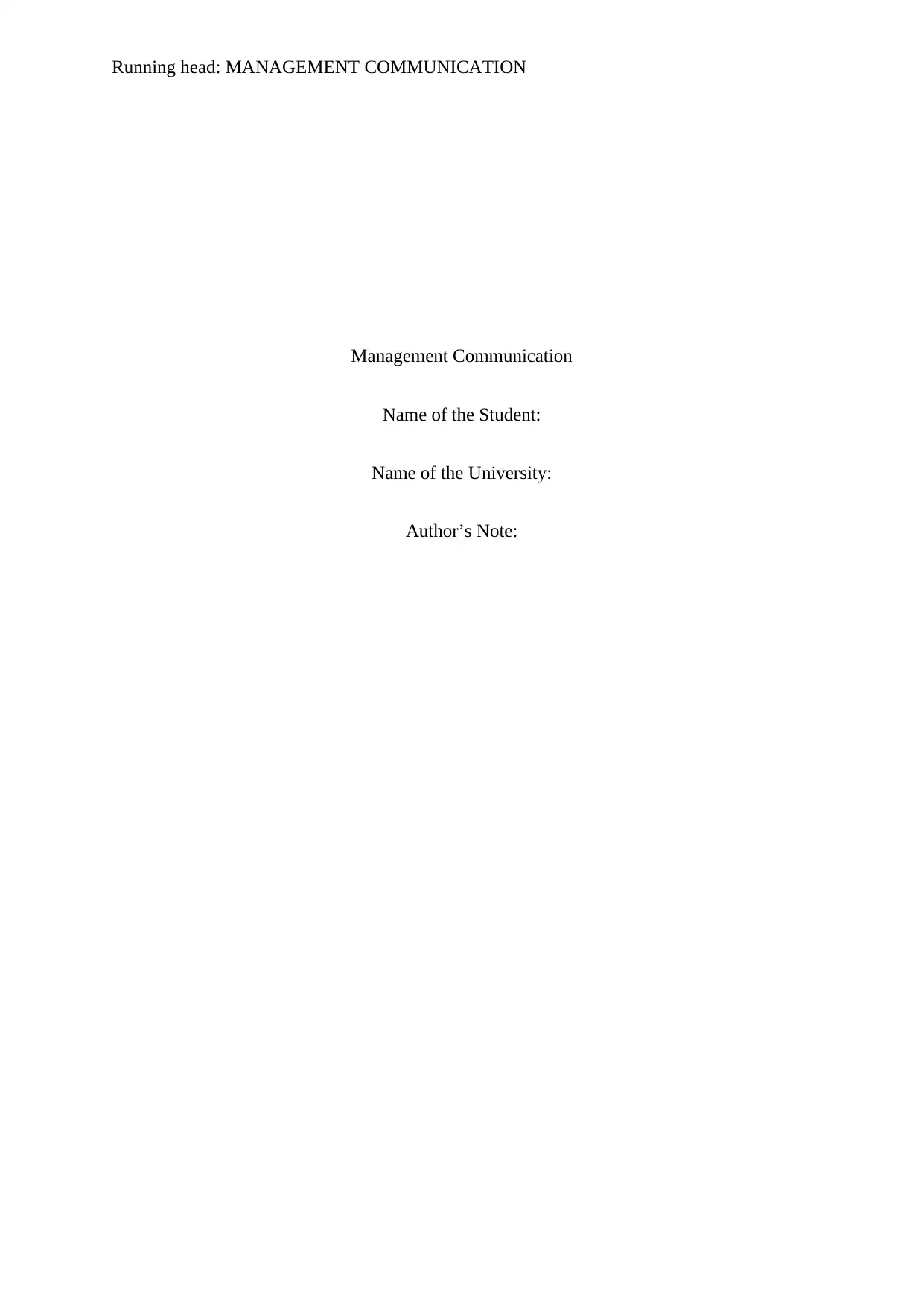
Running head: MANAGEMENT COMMUNICATION
Management Communication
Name of the Student:
Name of the University:
Author’s Note:
Management Communication
Name of the Student:
Name of the University:
Author’s Note:
Paraphrase This Document
Need a fresh take? Get an instant paraphrase of this document with our AI Paraphraser
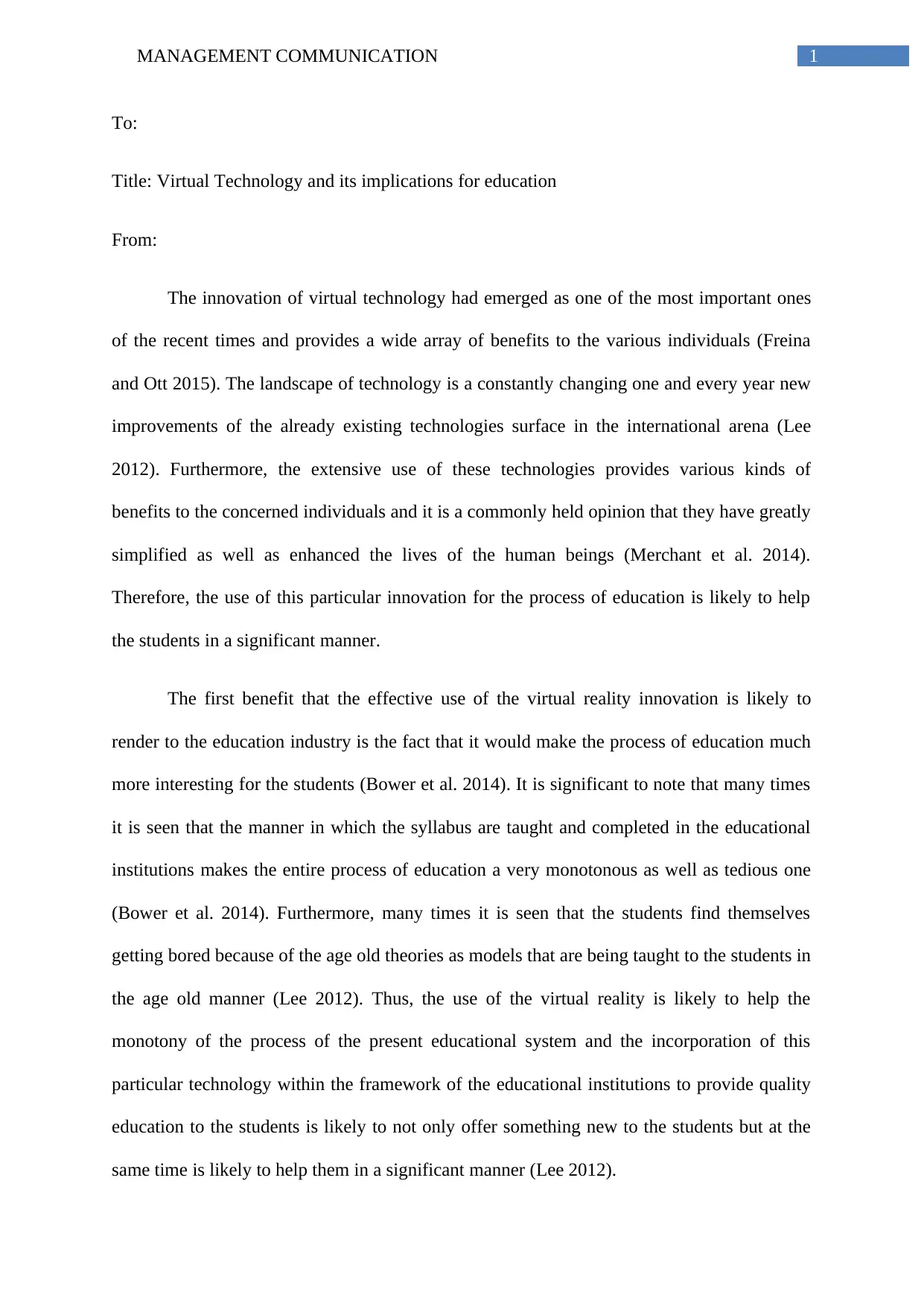
1MANAGEMENT COMMUNICATION
To:
Title: Virtual Technology and its implications for education
From:
The innovation of virtual technology had emerged as one of the most important ones
of the recent times and provides a wide array of benefits to the various individuals (Freina
and Ott 2015). The landscape of technology is a constantly changing one and every year new
improvements of the already existing technologies surface in the international arena (Lee
2012). Furthermore, the extensive use of these technologies provides various kinds of
benefits to the concerned individuals and it is a commonly held opinion that they have greatly
simplified as well as enhanced the lives of the human beings (Merchant et al. 2014).
Therefore, the use of this particular innovation for the process of education is likely to help
the students in a significant manner.
The first benefit that the effective use of the virtual reality innovation is likely to
render to the education industry is the fact that it would make the process of education much
more interesting for the students (Bower et al. 2014). It is significant to note that many times
it is seen that the manner in which the syllabus are taught and completed in the educational
institutions makes the entire process of education a very monotonous as well as tedious one
(Bower et al. 2014). Furthermore, many times it is seen that the students find themselves
getting bored because of the age old theories as models that are being taught to the students in
the age old manner (Lee 2012). Thus, the use of the virtual reality is likely to help the
monotony of the process of the present educational system and the incorporation of this
particular technology within the framework of the educational institutions to provide quality
education to the students is likely to not only offer something new to the students but at the
same time is likely to help them in a significant manner (Lee 2012).
To:
Title: Virtual Technology and its implications for education
From:
The innovation of virtual technology had emerged as one of the most important ones
of the recent times and provides a wide array of benefits to the various individuals (Freina
and Ott 2015). The landscape of technology is a constantly changing one and every year new
improvements of the already existing technologies surface in the international arena (Lee
2012). Furthermore, the extensive use of these technologies provides various kinds of
benefits to the concerned individuals and it is a commonly held opinion that they have greatly
simplified as well as enhanced the lives of the human beings (Merchant et al. 2014).
Therefore, the use of this particular innovation for the process of education is likely to help
the students in a significant manner.
The first benefit that the effective use of the virtual reality innovation is likely to
render to the education industry is the fact that it would make the process of education much
more interesting for the students (Bower et al. 2014). It is significant to note that many times
it is seen that the manner in which the syllabus are taught and completed in the educational
institutions makes the entire process of education a very monotonous as well as tedious one
(Bower et al. 2014). Furthermore, many times it is seen that the students find themselves
getting bored because of the age old theories as models that are being taught to the students in
the age old manner (Lee 2012). Thus, the use of the virtual reality is likely to help the
monotony of the process of the present educational system and the incorporation of this
particular technology within the framework of the educational institutions to provide quality
education to the students is likely to not only offer something new to the students but at the
same time is likely to help them in a significant manner (Lee 2012).
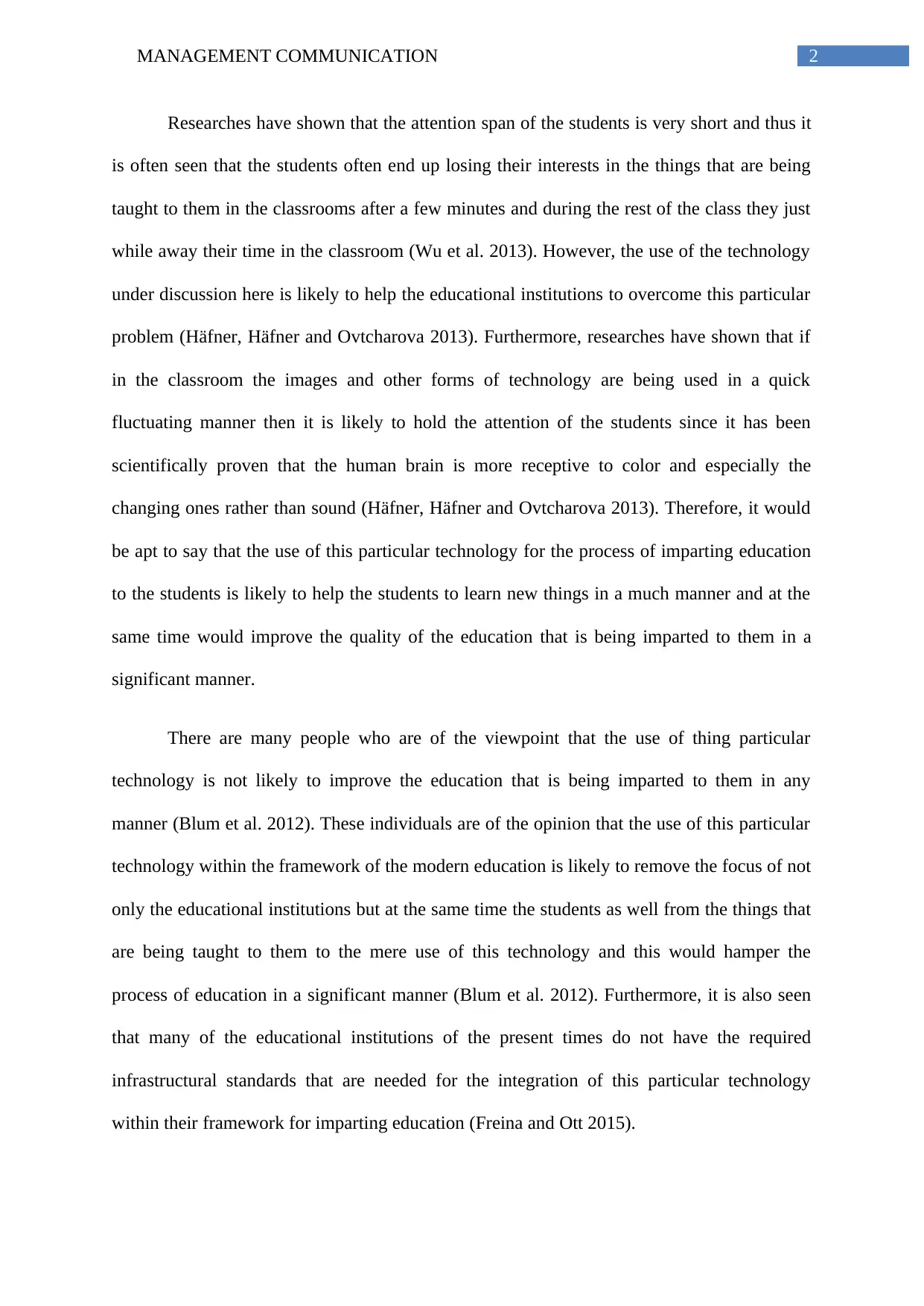
2MANAGEMENT COMMUNICATION
Researches have shown that the attention span of the students is very short and thus it
is often seen that the students often end up losing their interests in the things that are being
taught to them in the classrooms after a few minutes and during the rest of the class they just
while away their time in the classroom (Wu et al. 2013). However, the use of the technology
under discussion here is likely to help the educational institutions to overcome this particular
problem (Häfner, Häfner and Ovtcharova 2013). Furthermore, researches have shown that if
in the classroom the images and other forms of technology are being used in a quick
fluctuating manner then it is likely to hold the attention of the students since it has been
scientifically proven that the human brain is more receptive to color and especially the
changing ones rather than sound (Häfner, Häfner and Ovtcharova 2013). Therefore, it would
be apt to say that the use of this particular technology for the process of imparting education
to the students is likely to help the students to learn new things in a much manner and at the
same time would improve the quality of the education that is being imparted to them in a
significant manner.
There are many people who are of the viewpoint that the use of thing particular
technology is not likely to improve the education that is being imparted to them in any
manner (Blum et al. 2012). These individuals are of the opinion that the use of this particular
technology within the framework of the modern education is likely to remove the focus of not
only the educational institutions but at the same time the students as well from the things that
are being taught to them to the mere use of this technology and this would hamper the
process of education in a significant manner (Blum et al. 2012). Furthermore, it is also seen
that many of the educational institutions of the present times do not have the required
infrastructural standards that are needed for the integration of this particular technology
within their framework for imparting education (Freina and Ott 2015).
Researches have shown that the attention span of the students is very short and thus it
is often seen that the students often end up losing their interests in the things that are being
taught to them in the classrooms after a few minutes and during the rest of the class they just
while away their time in the classroom (Wu et al. 2013). However, the use of the technology
under discussion here is likely to help the educational institutions to overcome this particular
problem (Häfner, Häfner and Ovtcharova 2013). Furthermore, researches have shown that if
in the classroom the images and other forms of technology are being used in a quick
fluctuating manner then it is likely to hold the attention of the students since it has been
scientifically proven that the human brain is more receptive to color and especially the
changing ones rather than sound (Häfner, Häfner and Ovtcharova 2013). Therefore, it would
be apt to say that the use of this particular technology for the process of imparting education
to the students is likely to help the students to learn new things in a much manner and at the
same time would improve the quality of the education that is being imparted to them in a
significant manner.
There are many people who are of the viewpoint that the use of thing particular
technology is not likely to improve the education that is being imparted to them in any
manner (Blum et al. 2012). These individuals are of the opinion that the use of this particular
technology within the framework of the modern education is likely to remove the focus of not
only the educational institutions but at the same time the students as well from the things that
are being taught to them to the mere use of this technology and this would hamper the
process of education in a significant manner (Blum et al. 2012). Furthermore, it is also seen
that many of the educational institutions of the present times do not have the required
infrastructural standards that are needed for the integration of this particular technology
within their framework for imparting education (Freina and Ott 2015).
⊘ This is a preview!⊘
Do you want full access?
Subscribe today to unlock all pages.

Trusted by 1+ million students worldwide
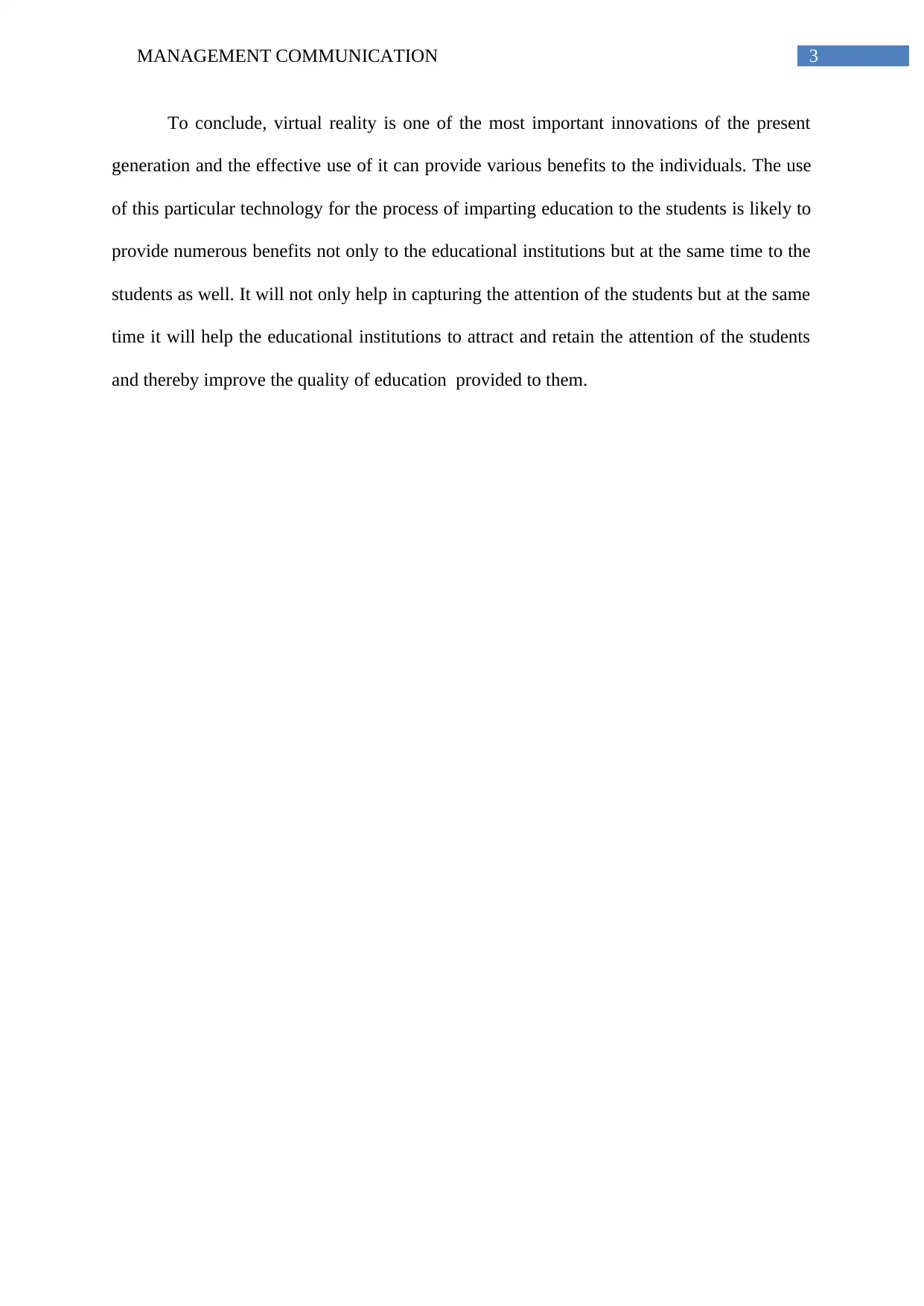
3MANAGEMENT COMMUNICATION
To conclude, virtual reality is one of the most important innovations of the present
generation and the effective use of it can provide various benefits to the individuals. The use
of this particular technology for the process of imparting education to the students is likely to
provide numerous benefits not only to the educational institutions but at the same time to the
students as well. It will not only help in capturing the attention of the students but at the same
time it will help the educational institutions to attract and retain the attention of the students
and thereby improve the quality of education provided to them.
To conclude, virtual reality is one of the most important innovations of the present
generation and the effective use of it can provide various benefits to the individuals. The use
of this particular technology for the process of imparting education to the students is likely to
provide numerous benefits not only to the educational institutions but at the same time to the
students as well. It will not only help in capturing the attention of the students but at the same
time it will help the educational institutions to attract and retain the attention of the students
and thereby improve the quality of education provided to them.
Paraphrase This Document
Need a fresh take? Get an instant paraphrase of this document with our AI Paraphraser
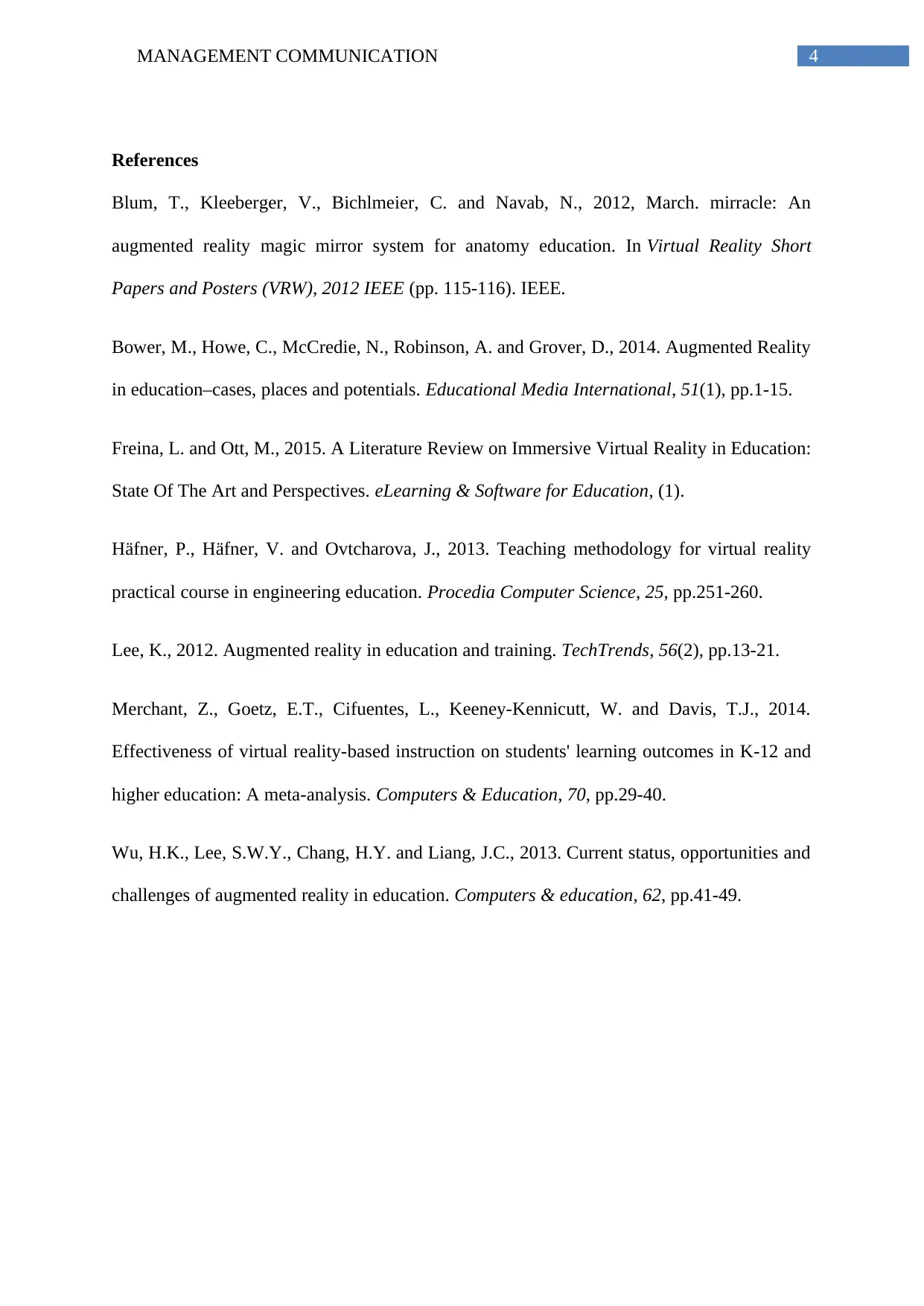
4MANAGEMENT COMMUNICATION
References
Blum, T., Kleeberger, V., Bichlmeier, C. and Navab, N., 2012, March. mirracle: An
augmented reality magic mirror system for anatomy education. In Virtual Reality Short
Papers and Posters (VRW), 2012 IEEE (pp. 115-116). IEEE.
Bower, M., Howe, C., McCredie, N., Robinson, A. and Grover, D., 2014. Augmented Reality
in education–cases, places and potentials. Educational Media International, 51(1), pp.1-15.
Freina, L. and Ott, M., 2015. A Literature Review on Immersive Virtual Reality in Education:
State Of The Art and Perspectives. eLearning & Software for Education, (1).
Häfner, P., Häfner, V. and Ovtcharova, J., 2013. Teaching methodology for virtual reality
practical course in engineering education. Procedia Computer Science, 25, pp.251-260.
Lee, K., 2012. Augmented reality in education and training. TechTrends, 56(2), pp.13-21.
Merchant, Z., Goetz, E.T., Cifuentes, L., Keeney-Kennicutt, W. and Davis, T.J., 2014.
Effectiveness of virtual reality-based instruction on students' learning outcomes in K-12 and
higher education: A meta-analysis. Computers & Education, 70, pp.29-40.
Wu, H.K., Lee, S.W.Y., Chang, H.Y. and Liang, J.C., 2013. Current status, opportunities and
challenges of augmented reality in education. Computers & education, 62, pp.41-49.
References
Blum, T., Kleeberger, V., Bichlmeier, C. and Navab, N., 2012, March. mirracle: An
augmented reality magic mirror system for anatomy education. In Virtual Reality Short
Papers and Posters (VRW), 2012 IEEE (pp. 115-116). IEEE.
Bower, M., Howe, C., McCredie, N., Robinson, A. and Grover, D., 2014. Augmented Reality
in education–cases, places and potentials. Educational Media International, 51(1), pp.1-15.
Freina, L. and Ott, M., 2015. A Literature Review on Immersive Virtual Reality in Education:
State Of The Art and Perspectives. eLearning & Software for Education, (1).
Häfner, P., Häfner, V. and Ovtcharova, J., 2013. Teaching methodology for virtual reality
practical course in engineering education. Procedia Computer Science, 25, pp.251-260.
Lee, K., 2012. Augmented reality in education and training. TechTrends, 56(2), pp.13-21.
Merchant, Z., Goetz, E.T., Cifuentes, L., Keeney-Kennicutt, W. and Davis, T.J., 2014.
Effectiveness of virtual reality-based instruction on students' learning outcomes in K-12 and
higher education: A meta-analysis. Computers & Education, 70, pp.29-40.
Wu, H.K., Lee, S.W.Y., Chang, H.Y. and Liang, J.C., 2013. Current status, opportunities and
challenges of augmented reality in education. Computers & education, 62, pp.41-49.
1 out of 5
Related Documents
Your All-in-One AI-Powered Toolkit for Academic Success.
+13062052269
info@desklib.com
Available 24*7 on WhatsApp / Email
![[object Object]](/_next/static/media/star-bottom.7253800d.svg)
Unlock your academic potential
Copyright © 2020–2025 A2Z Services. All Rights Reserved. Developed and managed by ZUCOL.




